 Web Front-end
Web Front-end
 JS Tutorial
JS Tutorial
 A brief discussion on the usage of parent-child tables and row and column ordering in Bootstrap table
A brief discussion on the usage of parent-child tables and row and column ordering in Bootstrap table
A brief discussion on the usage of parent-child tables and row and column ordering in Bootstrap table
this article combines the usage of the parent-child table and row-column ordering of the bootstrap table, and then introduces its slightly more advanced usage. it has certain reference value. friends in need can refer to it. i hope it will be helpful to everyone.
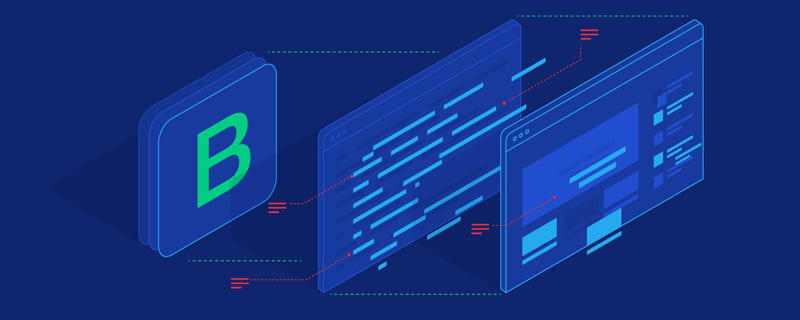
[related recommendations: "bootstrap tutorial》]
1. effect display
today we will change the method slightly and let’s take a look at the effect first. , the code implementation and precautions will be introduced later. come on, here are the renderings:
1. father-son table renderings
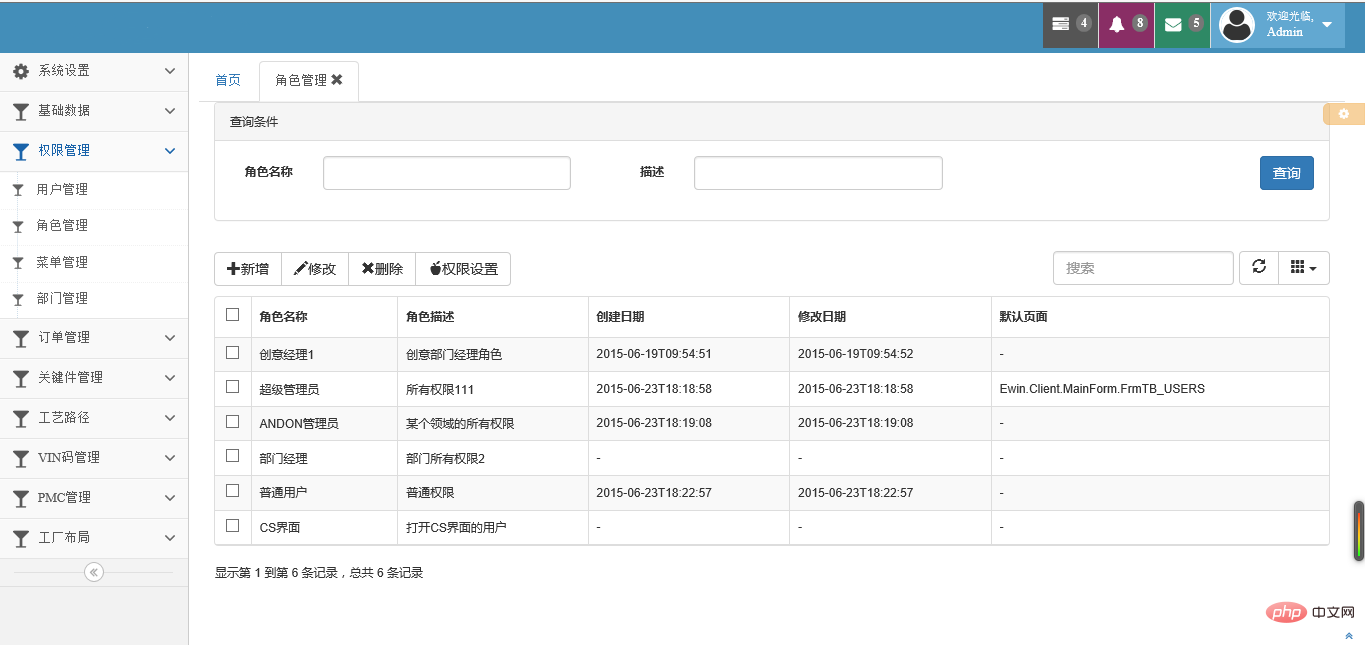
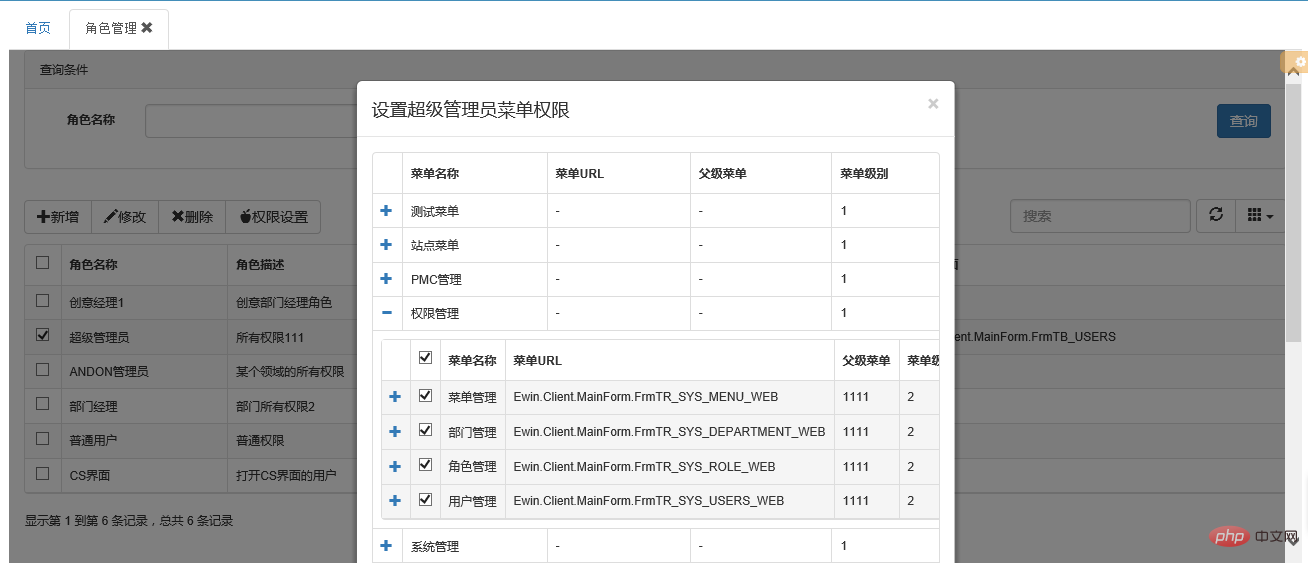
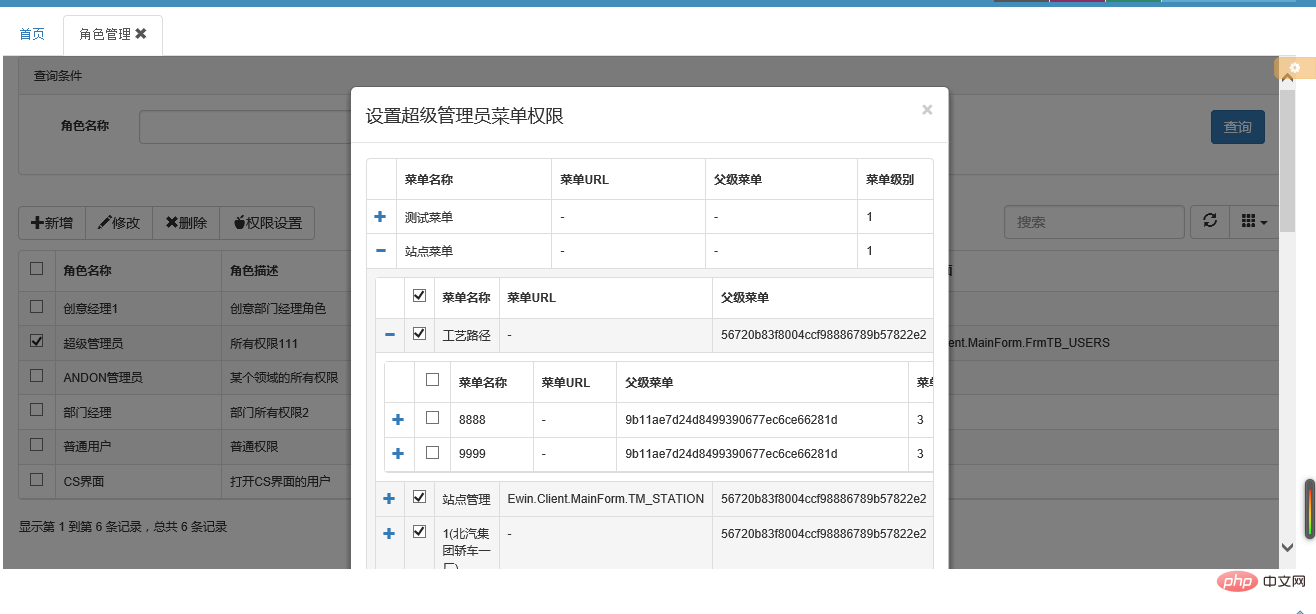
2. row reordering
before resequencing
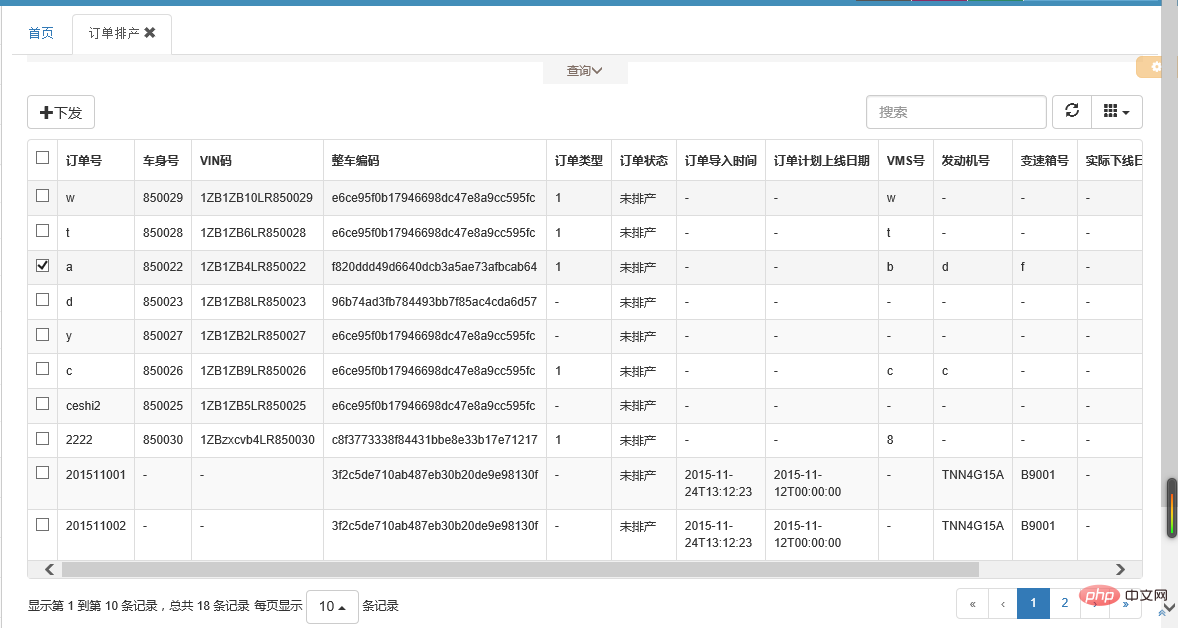
drag row reordering order to the first row
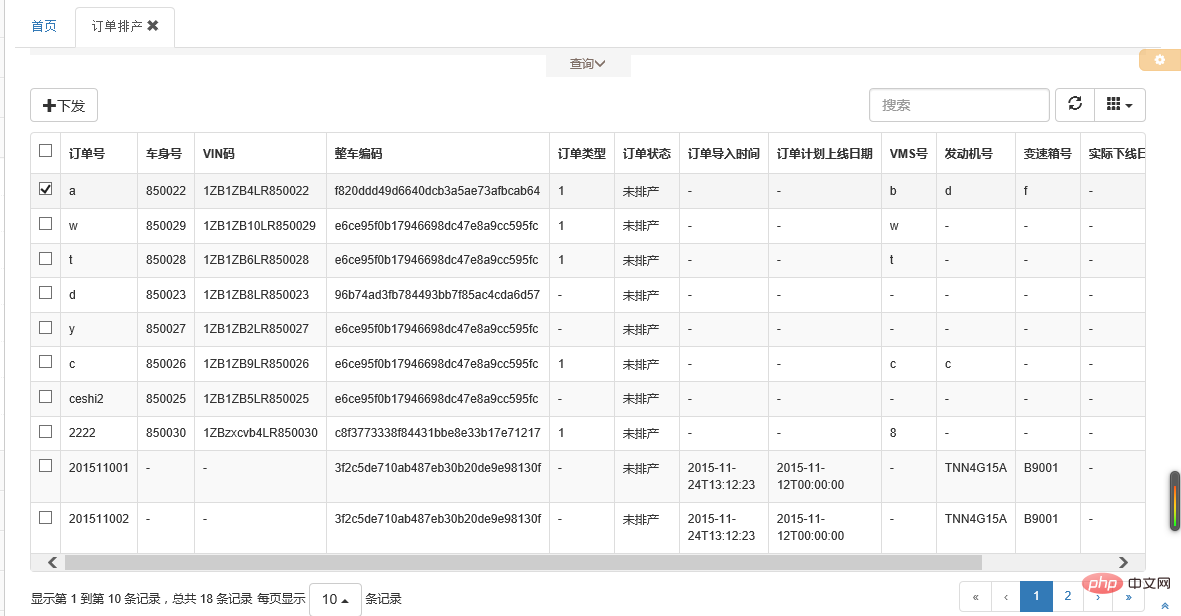
3. column ordering
before ordering
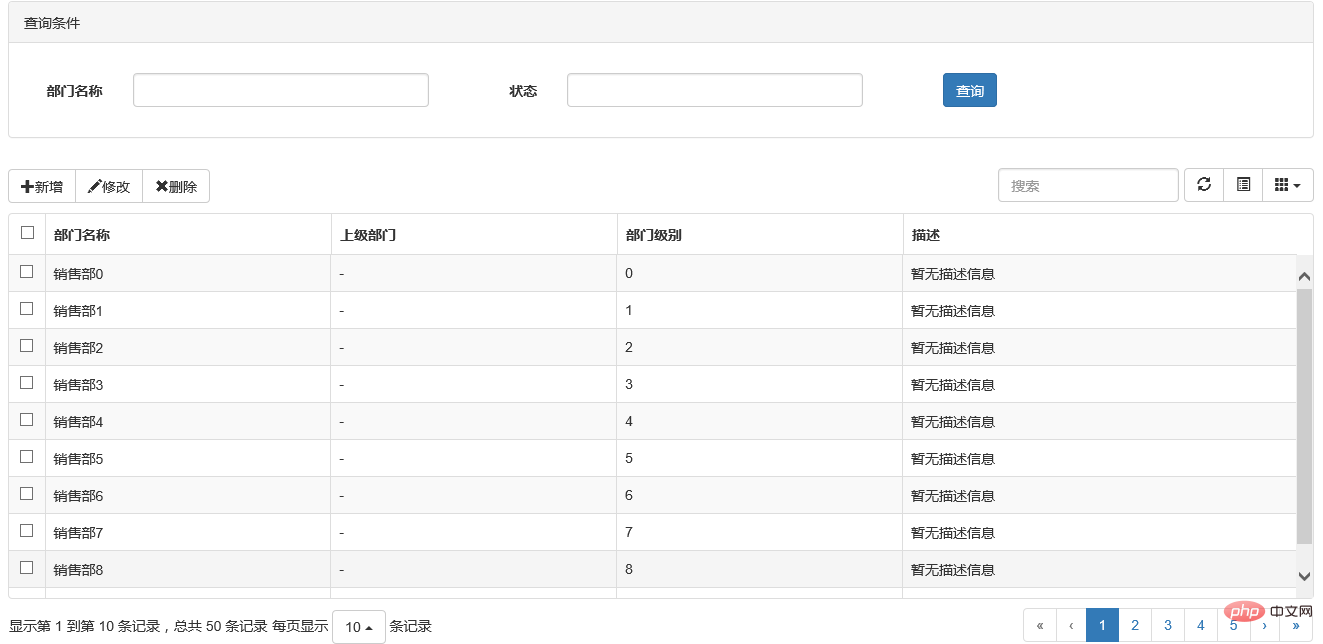
drag the column title to sort

after sorting
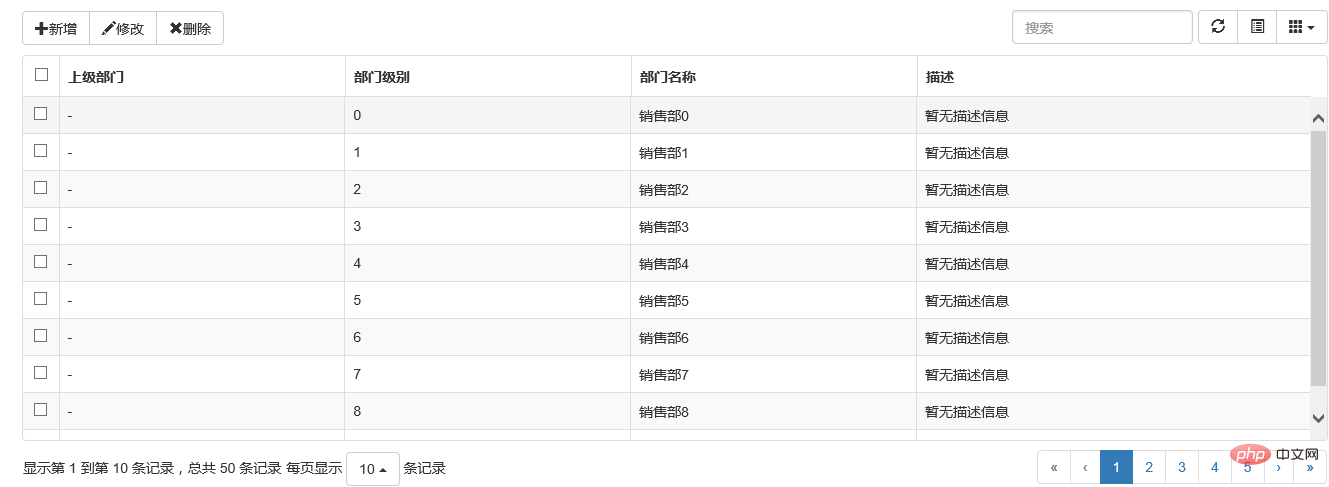
two , detailed explanation of the code of the parent-child table
in the previous chapter, we introduced the basic usage of the bootstrap table. when initializing the table, there is an attribute "detailview". set it to true, and in each row you can see an icon in the shape of " " in front of you. clicking this icon triggers the event of loading the subtable. this is the general principle. let's take a look at the code. it's actually very simple.
1. initialize the table and register the row expansion event
$("#tb_powerset").bootstraptable({
url: '/api/menuapi/getparentmenu',
method: 'get',
detailview: true,//父子表
//sidepagination: "server",
pagesize: 10,
pagelist: [10, 25],
columns: [{
field: 'menu_name',
title: '菜单名称'
}, {
field: 'menu_url',
title: '菜单url'
}, {
field: 'parent_id',
title: '父级菜单'
}, {
field: 'menu_level',
title: '菜单级别'
}, ], //注册加载子表的事件。注意下这里的三个参数!
onexpandrow: function (index, row, $detail) {
oinit.initsubtable(index, row, $detail);
}
});let’s take a look at the subtable loading event onexpandrow corresponding method function (index, row, $detail ),
index: the row index of the current row of the parent table.
row: json data object of the current row of the parent table.
$detail: the td object in the new row created below the current row.
the third parameter is particularly important because the generated subtable table is loaded in the $detail object. the bootstrap table generates the $detail object for us, and then we only need to fill it with the table we want.
2. let’s look at the oinit.initsubtable() method
//初始化子表格(无线循环)
oinit.initsubtable = function (index, row, $detail) { var parentid = row.menu_id; var cur_table = $detail.html('<table></table>').find('table');
$(cur_table).bootstraptable({
url: '/api/menuapi/getchildrenmenu',
method: 'get',
queryparams: { strparentid: parentid },
ajaxoptions: { strparentid: parentid },
clicktoselect: true,
detailview: true,//父子表
uniqueid: "menu_id",
pagesize: 10,
pagelist: [10, 25],
columns: [{
checkbox: true
}, {
field: 'menu_name',
title: '菜单名称'
}, {
field: 'menu_url',
title: '菜单url'
}, {
field: 'parent_id',
title: '父级菜单'
}, {
field: 'menu_level',
title: '菜单级别'
}, ], //无线循环取子表,直到子表里面没有记录
onexpandrow: function (index, row, $subdetail) {
oinit.initsubtable(index, row, $subdetail);
}
});
};it can be seen that the principle of generating a subtable is to create a table object cur_table , and then register the table initialization of this object. isn’t it very simple~~
3. detailed explanation of the row sequence code
the row sequence code is even simpler, let’s take a look.
1. two additional js files need to be referenced
<script src="~/content/jquery-ui-1.11.4.custom/external/jquery.tablednd.js"></script> <script src="~/content/bootstrap-table/extensions/reorder-rows/bootstrap-table-reorder-rows.js"></script>
2. when defining the table on the cshtml page, add two attributes
<table id="tb_order" data-use-row-attr-func="true" data-reorderable-rows="true"></table>
then there is no need to make any modifications when the js table is initialized, and the loaded table can realize the row ordering function.
4. detailed explanation of column ordering code
it is similar to row ordering. the use of column ordering is as follows:
1. reference a few additional js and css
<script src="~/content/bootstrap-table/extensions/reorder-columns/bootstrap-table-reorder-columns.js"></script> <link rel="stylesheet" href="../assets/examples.css"> <link rel="stylesheet" href="https://rawgit.com/akottr/dragtable/master/dragtable.css"> <script src="https://code.jquery.com/ui/1.11.4/jquery-ui.js"></script> <script src="https://rawgit.com/akottr/dragtable/master/jquery.dragtable.js"></script> <script src="https://code.jquery.com/ui/1.11.4/jquery-ui.js"></script> <script src="https://code.jquery.com/ui/1.11.4/jquery-ui.js"></script>
2. when defining the table on the cshtml page, add an attribute
<table id="tb_departments" data-reorderable-columns="true"></table>
no need to make any modifications elsewhere. the loaded table can be sorted by columns. is it very simple?
5. control filtering
i was about to end this article, but suddenly i remembered that there was a search function in the previous chapter. it seems that the search function is not available when the server is paging. after using it, i remembered that i had done a function similar to filtering each column in cs before. the blogger became curious again. does bootstrap table also have this function of filtering each column of the table, so i checked the document. the result lives up to expectations, it really works~~ let’s take a look.
1. rendering display
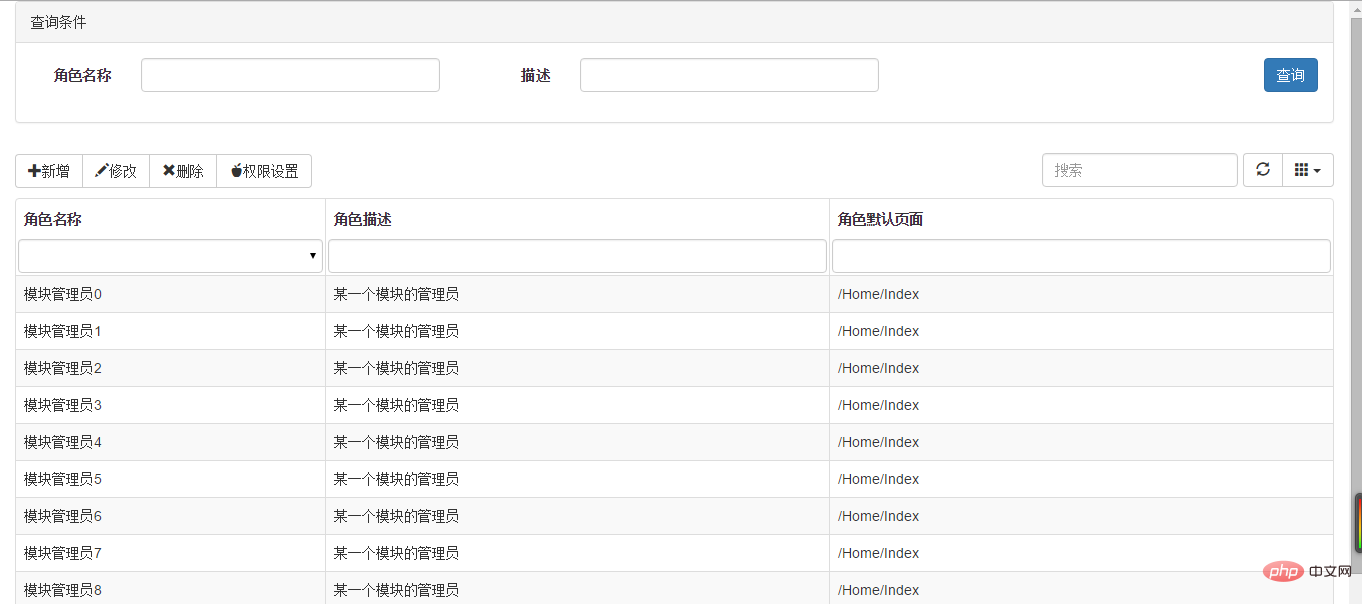
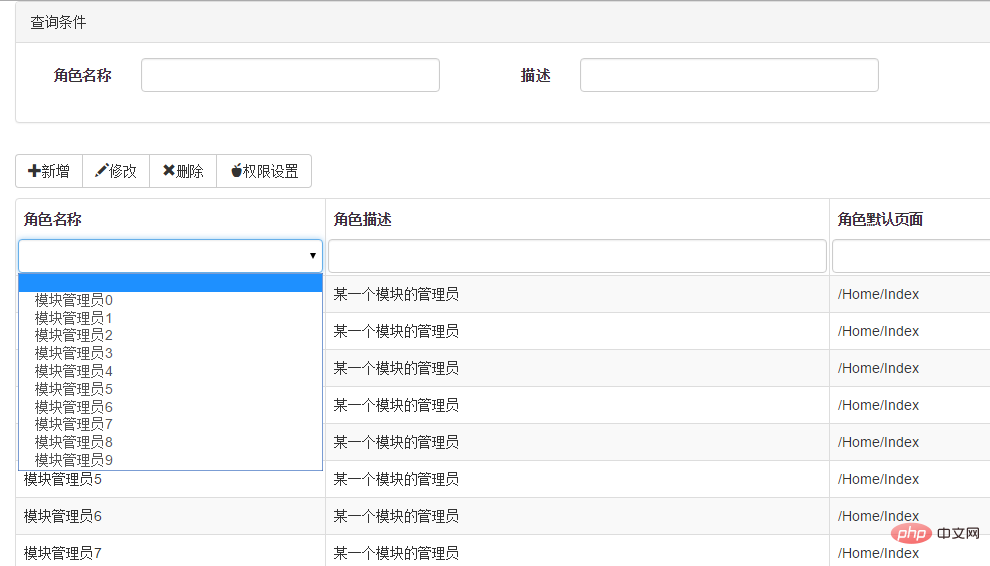


2. code example
(1) introduce additional js
<script src="~/content/bootstrap-table/extensions/filter-control/bootstrap-table-filter-control.js"></script>
(2) define table attributes and header attributes
<table id="tb_roles" data-filter-control="true"> <thead> <tr> <th data-field="role_name" data-filter-control="select">角色名称</th> <th data-field="description" data-filter-control="input">角色描述</th> <th data-field="role_defaulturl" data-filter-control="input">角色默认页面</th> </tr> </thead> </table>
because the header attributes are defined here, there is no need to define columns when js is initialized.
(3) js initialization
$('#tb_roles').bootstrapTable({
url: '/Role/GetRole',
method: 'get',
toolbar: '#toolbar',
striped: true,
cache: false,
striped: true,
pagination: true,
sortable: true,
queryParams: function (param) { return param;
},
queryParamsType: "limit",
detailView: false,//父子表
sidePagination: "server",
pageSize: 10,
pageList: [10, 25, 50, 100],
search: true,
showColumns: true,
showRefresh: true,
minimumCountColumns: 2,
clickToSelect: true,
});at first, the blogger thought this the search can only be done by client-side paging, but after debugging, it was found that this is not the case. it turns out that the search conditions can be passed to the server through json. let's look at the debugging process
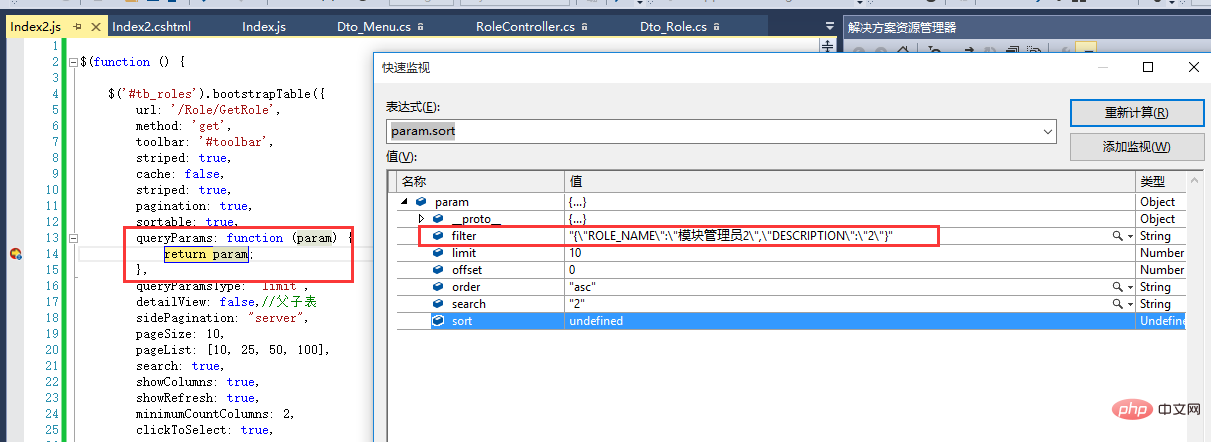
receive parameters in the background and deserialize them
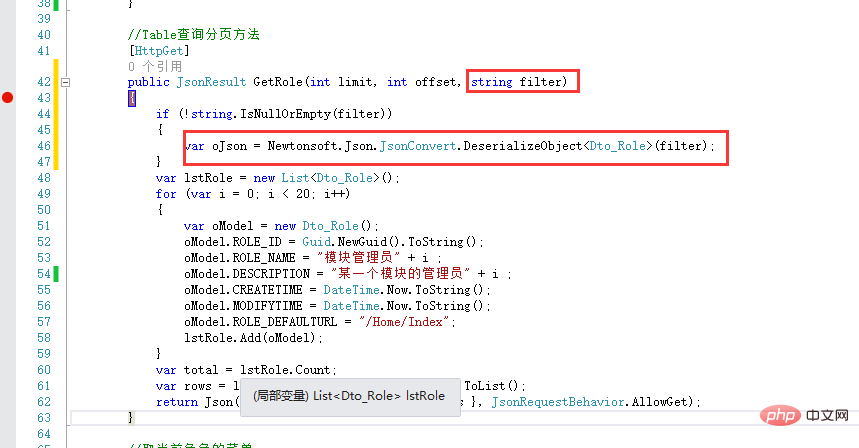
this way we can pass the query conditions to the background. very good and powerful. this eliminates the trouble of extending the table search function~~
6. summary
the above are some extended applications of bootstrap table. it may not be comprehensive, and some advanced usages are not introduced, such as merging rows and columns, freezing rows, etc. but the blogger believes that as long as there are documents, there should be no problem in using it. the source code still needs to be sorted out and will be uploaded after it is sorted out. garden friends, let’s take a look first! !
for more programming-related knowledge, please visit: introduction to programming! !

Hot AI Tools

Undresser.AI Undress
AI-powered app for creating realistic nude photos

AI Clothes Remover
Online AI tool for removing clothes from photos.

Undress AI Tool
Undress images for free

Clothoff.io
AI clothes remover

Video Face Swap
Swap faces in any video effortlessly with our completely free AI face swap tool!

Hot Article

Hot Tools

Notepad++7.3.1
Easy-to-use and free code editor

SublimeText3 Chinese version
Chinese version, very easy to use

Zend Studio 13.0.1
Powerful PHP integrated development environment

Dreamweaver CS6
Visual web development tools

SublimeText3 Mac version
God-level code editing software (SublimeText3)

Hot Topics
 1677
1677
 14
14
 1431
1431
 52
52
 1334
1334
 25
25
 1279
1279
 29
29
 1257
1257
 24
24
 Python vs. JavaScript: The Learning Curve and Ease of Use
Apr 16, 2025 am 12:12 AM
Python vs. JavaScript: The Learning Curve and Ease of Use
Apr 16, 2025 am 12:12 AM
Python is more suitable for beginners, with a smooth learning curve and concise syntax; JavaScript is suitable for front-end development, with a steep learning curve and flexible syntax. 1. Python syntax is intuitive and suitable for data science and back-end development. 2. JavaScript is flexible and widely used in front-end and server-side programming.
 JavaScript and the Web: Core Functionality and Use Cases
Apr 18, 2025 am 12:19 AM
JavaScript and the Web: Core Functionality and Use Cases
Apr 18, 2025 am 12:19 AM
The main uses of JavaScript in web development include client interaction, form verification and asynchronous communication. 1) Dynamic content update and user interaction through DOM operations; 2) Client verification is carried out before the user submits data to improve the user experience; 3) Refreshless communication with the server is achieved through AJAX technology.
 JavaScript in Action: Real-World Examples and Projects
Apr 19, 2025 am 12:13 AM
JavaScript in Action: Real-World Examples and Projects
Apr 19, 2025 am 12:13 AM
JavaScript's application in the real world includes front-end and back-end development. 1) Display front-end applications by building a TODO list application, involving DOM operations and event processing. 2) Build RESTfulAPI through Node.js and Express to demonstrate back-end applications.
 Understanding the JavaScript Engine: Implementation Details
Apr 17, 2025 am 12:05 AM
Understanding the JavaScript Engine: Implementation Details
Apr 17, 2025 am 12:05 AM
Understanding how JavaScript engine works internally is important to developers because it helps write more efficient code and understand performance bottlenecks and optimization strategies. 1) The engine's workflow includes three stages: parsing, compiling and execution; 2) During the execution process, the engine will perform dynamic optimization, such as inline cache and hidden classes; 3) Best practices include avoiding global variables, optimizing loops, using const and lets, and avoiding excessive use of closures.
 Python vs. JavaScript: Development Environments and Tools
Apr 26, 2025 am 12:09 AM
Python vs. JavaScript: Development Environments and Tools
Apr 26, 2025 am 12:09 AM
Both Python and JavaScript's choices in development environments are important. 1) Python's development environment includes PyCharm, JupyterNotebook and Anaconda, which are suitable for data science and rapid prototyping. 2) The development environment of JavaScript includes Node.js, VSCode and Webpack, which are suitable for front-end and back-end development. Choosing the right tools according to project needs can improve development efficiency and project success rate.
 The Role of C/C in JavaScript Interpreters and Compilers
Apr 20, 2025 am 12:01 AM
The Role of C/C in JavaScript Interpreters and Compilers
Apr 20, 2025 am 12:01 AM
C and C play a vital role in the JavaScript engine, mainly used to implement interpreters and JIT compilers. 1) C is used to parse JavaScript source code and generate an abstract syntax tree. 2) C is responsible for generating and executing bytecode. 3) C implements the JIT compiler, optimizes and compiles hot-spot code at runtime, and significantly improves the execution efficiency of JavaScript.
 From Websites to Apps: The Diverse Applications of JavaScript
Apr 22, 2025 am 12:02 AM
From Websites to Apps: The Diverse Applications of JavaScript
Apr 22, 2025 am 12:02 AM
JavaScript is widely used in websites, mobile applications, desktop applications and server-side programming. 1) In website development, JavaScript operates DOM together with HTML and CSS to achieve dynamic effects and supports frameworks such as jQuery and React. 2) Through ReactNative and Ionic, JavaScript is used to develop cross-platform mobile applications. 3) The Electron framework enables JavaScript to build desktop applications. 4) Node.js allows JavaScript to run on the server side and supports high concurrent requests.
 Python vs. JavaScript: Use Cases and Applications Compared
Apr 21, 2025 am 12:01 AM
Python vs. JavaScript: Use Cases and Applications Compared
Apr 21, 2025 am 12:01 AM
Python is more suitable for data science and automation, while JavaScript is more suitable for front-end and full-stack development. 1. Python performs well in data science and machine learning, using libraries such as NumPy and Pandas for data processing and modeling. 2. Python is concise and efficient in automation and scripting. 3. JavaScript is indispensable in front-end development and is used to build dynamic web pages and single-page applications. 4. JavaScript plays a role in back-end development through Node.js and supports full-stack development.



